
Guest contributor: Kristen Keckler
Getting Outside Saturday: Garlic Girl
categories: Cocktail Hour / Getting Outside
14 comments
It’s the night before my “work” visit to Stoneledge Farm in Leeds, New York, and I’m in bed, wide awake, thinking about vampires. I’m going to spend the next day picking garlic, tons of it, and garlic makes me think of salsa, pesto, and, inevitably, a natural repellant for blood suckers. Instead of winding down, I’m wired, feel as if I’ve been popping chocolate-covered espresso beans. I feel like I did when I was a little kid—my body abuzz with anticipation—the night before a school trip.
Bright and early, my boyfriend, Scott, runs to the bakery to get some fresh hard rolls and we make veggie and cheese sandwiches, lots of spicy mustard. I’m shoving last-minute supplies—sunscreen, gardening gloves, trail mix, bathing suit, Advil—into my pack and we’re off! Over the Newburgh Beacon Bridge, hook up with the great New York State Thruway, passing exits for New Paltz, Woodstock, Saugerties, blasting Bob Dylan, windows open, breathing the fresh country air. We’re gonna pull garlic! Gonna work on Maggie’s Farm! Gonna see where our fruits and veggies are grown!
The GPS lady gets us to Garcia Lane no problem, and we pull into the farm at about a quarter past ten. I’m a little nervous that we’re late—the email clearly stated the workday starts at ten! But the farmers are way too busy to notice. We park next to a barn, and a middle-aged man with a white crew cut, tanned arms, and cut-off jean shorts introduces himself as Pete, asks where we were from—Ossining—and if it’s our first time to the farm—yes.
It’s only my first year joining a CSA (this stands for Community Supported Agriculture, of course) and already I’ve been calling it “our” farm. Stoneledge delivers to nineteen different CSAs in the New York area and has over 1900 members; you buy a “share” and get a box of produce each week, June through November. You pay for your portion of a season’s harvest upfront, usually by March, so the farm has operating funds. It’s also kind of like gambling with food. You get vegetables that line up with the season—no tomatoes in June or July, but come August, you’ll feel like you hit the tomato jackpot. Unless, that is, the weather has been too wet and the tomatoes get bit with the blight. No payoff without risk, right?
It’s also actually the first time I’ve ever, like, worked on a farm. My idea of exercise is walking to the corner deli for a six-pack and watching the Olympics.
Pete tells us to hop in his pickup and minutes later, we’re in a field, a football-field sized section out of their 200 sprawling acres. The muted blue-gray humps of the Catskill Mountains rise above the
tree line on the outskirts of the farm. Pete’s showing us what to do—see those long, dried stalky thing sticking out of the ground—that’s the garlic. Pull from the bottom, dislodge a white bulb the size of a fat, subterranean rosebud, long roots hanging down like a gnarly beard, twisted in clumps of dirt. Pull another, shake off the dirt, and when you have ten, wrap the tops of the stalks with a red rubber band. Eight bunches to a double-sized milk crate. The ground is dry and crumbly—they haven’t had a good rain in about a month—so the garlic dislodges pretty easily. The first few bulbs do at least.
I put on my gardening gloves and fall to work among the others—Pete’s son, Peter, three of their full-time Mexican workers, and strong-looking blonde teenager. Bend, pull, bend, pull, knock the bulbs together to clear off the dirt. The garlic, I learn, is a sort of Porcelain and German Stripe hybrid—mostly white, but some have a hint of purple—and was planted last October, will be stored in the barn to dry until this October. A whole year from ground to table!
Peter Jr. is a tall, blond twenty-something with streaks of sunburn across his fair cheeks. He mentions a softball game that evening, says something to the guys in Spanish, and the Mexicans laugh and say, “Baseball, si, si, si.”
Peter explains, “I play in a local softball league, but sometimes, half the guys don’t show up, so tonight I’m going to bring the team with me.”
Peter asks us how we like the veggies so far, and I say everything’s been great and he says lots of greens and I joke that I’ve figured out some stuff to do with garlic scapes—there have been plenty. “Chop and sprinkle on top of sour cream, a garnish for chili,” I say, showing off a little.
Scott and I are the only CSA members who have shown up to work. Last year, a group came from the Manhattan CSA, but Peter speculates that the heat this summer probably kept people away. I feel superior to the Mahattanites, as Peter calls them, for a good thirty seconds. It is hot, not as hot as it’s been, but already in the low 80s, 50% humidity, and the sun blazes through a light haze of clouds. I feel it on my shoulders, my face.
Soon, the chitchat dies down and we’re all just working, the only sound the buzzing of bugs. I have to remove my gloves to get the rubber band around the stalks, so I try working without gloves for a while, and soon my hands are bright red and chaffed, fingernails crusted with dirt, cuticles tender and raw. I try to work quickly, wanting to be a semi-serious farm hand, not some soft suburbanite, but I already feel the tension in my back, my shoulders, my calves. I stretch my shoulders, feel a pinch in my neck. By the time I have one crate filled—eighty heads of garlic!—the workers have progressed a quarter way down the row, and fifteen more minutes, they’ve blown way past us, almost halfway down the field.
I need a new strategy so I decide to pull the garlic and stack piles of ten on the side, and when I have enough piles, take off the gloves and wrap them with rubber bands. The smell is simultaneously pungent and mild, like a hint of wild green onion in the wind. I try squatting in the dirt rather than bending from the waist, easier on my back, but not as much leverage. In the distance, on a hill beyond the fields, there’s a white barn. Pete Jr. is driving a large piece of farm equipment—some kind of tiller?—to the other side of the field. Pete Sr. returns with a flatbed truck full of milk crates, and drives onto the field; I’m mesmerized by the spectacular wake of dust, the rust-tinted plumes.
Dog! Looks part chocolate lab, is running from a far field, running like a tiger, bounding right at me. I’m a little afraid of dogs, still have the ghost of a scar between my eyes from my parents’ late, crazy cockapoo, but this one must be friendly, right? He’s like a runner sliding into second base—me—and I affect my fake-friendly I-love-strange-dogs voice, saying, “What a nice puppy!” as he gives me a quick circle, sniff, lick, then runs off.
Water, I think, and after a couple chugs, fall back to the rhythm of pulling, knocking, counting, wrapping. As I tug the rubber band over the bunch of dry stalks, it snaps, drat, try another, more gently this time. I stack milk crate after milk crate on the flat bed. My shins are caked with dirt. My bra straps are constantly sliding off my shoulders and my tank top is drenched in sweat. There’s a breeze and it feels so cool and refreshing across my wet back that for a moment, I have an epiphany about the brilliance of the body’s natural cooling system. In the field adjacent, there’s what looks like summer squash, and at the end of the field, big baskets of brownish-yellow gourds. An old red bicycle is artfully propped up against a tree.
Scott has the camera, points it at me, says, “Hey, garlic girl!” and I strike a pose with fistfuls of stalks.
Pete Sr. pulls up in the pickup, unloads two more visitors, fit grandmother types from the Stamford, Connecticut CSA. The one with the floppy straw hat is a talker, explains what exit they took, and a discussion ensues about the fact that the farm address is Leeds but it is actually in South Cairo, and they had to ask someone at a gas station. Soon after the newcomers arrive, Pete’s wife, Deborah, arrives on foot to announce that it’s lunchtime.
Lunch! I can almost taste my cheese and jalapeno sandwich on the fresh hard roll.
Deborah wears her curly gray-blonde hair in a ponytail under a navy conductor’s cap, wears pinstriped jeans and a dark tank top, has a soothing girlish voice and a sweet smile.
The dog—a she—is back, then off again, through the fields. Deborah tells us that the Mexican guys have adopted her. “She loves them,” she says. “It’s lunchtime and you see her take off—she goes up to their place. They feed her tortillas.” She thinks the dog helps their morale, keeps them company. “They’re far away from their families,” she says, explaining that they work nine months a year on a visa that allows them to go back and forth between Mexico and the farm. It’s expensive and a lot of paperwork but the right thing to do, Deborah says, to murmurs of approval.
She picks up a vegetable from the basket I thought was some sort of squash—it’s the size of a potato and the brownish-yellow color of a pear—and explains that it is actually an Indian cucumber—Poona Kheera. They’re so delicious, even crisper than regular cucumbers, she says, lamenting that the color makes them look less appetizing than they are. She hands me one, to try with my lunch, and as we walk back to the barn, she takes us on a tour, explaining how they rotate crops, showing us an empty field she hopes they can rest for three years. She points out great fans of chard, which has been harvested but is regenerating, and the rows of herbs, plucking a few leaves and handing them around—cinnamon basil. I take a whiff, smells like a Red Hot candy. Lime basil—citrusy, like a limeade. The sun is bright overhead—high noon.
She shows us the irrigation system that pumps water from a spring-fed pond into the fields. This season’s been dry, so they really need it. We walk to the next field, the okra—they’re a little overdue for harvest, she notices, picking a few longer, deep green tubes.
“I’m always trying to figure out ways to prepare it to get rid of the sliminess,” she says.
“Bet you can throw it on the grill,” Scott offers. You name it, and he’ll try it on the grill.
“In New Orleans, I had it pickled,” I say. “In a bloody Mary.”
Deborah says, “We should have some great tomatoes—they don’t mind hot and dry.” They have a lot of tomato plants this year, she explains, musing that she probably miscalculated somewhere along the lines when doing the seeding.
She pulls off a few bright orange heirloom cherry tomatoes and hands them around.
A burst of sweet, warm tomatoey goodness in my mouth.
It reminds me of my grandma. In the time before supermarkets set up stations with samples on toothpicks, my grandma created her own samples. I grew up in the suburbs of New York City way before CSAs and farmer’s markets entered hip, green vernacular, back when you got your produce from Pathmark, Walbaum’s, or Finest. My Sicilian grandmother would collect sales circulars from all the local supermarkets and often spend the afternoon cruising up and down Central Avenue from Yonkers to Hartsdale in her two-tone Buick, searching for the best deals. I remember how she’d shop for produce—she’d squeeze, inspect, smell, and otherwise fondle a head of lettuce or eggplant to make sure it was fresh. She’d even sneak a taste it if possible—I remember her, openly and defiantly, black eyes ablaze, popping grapes into her mouth, same with cherries and blueberries and anything small and loose. She wanted to make sure she got her money’s worth, yes, but more importantly, she knew the taste of whatever she was cooking depended on it. She often snuck me a grape to taste, and though I was aware that it was a suburban taboo, that you weren’t supposed to sample the produce, that it should be washed first, and that it was sort of like stealing, I quickly swallowed the evidence, duly noting whether it was perfectly sweet or slightly sour.
Back at the barn, we rinse our hands under a big plastic cooler of water and eat in the cool, shady shed on rustic benches, all unwrapping our sandwiches. Pete Jr. joins us and when they are sitting side by side, I see the strong resemblance between mother and son: high cheekbones, attractive hook noses.
Like a good boy scout, my boyfriend has his Swiss Army knife and cuts the brown Indian cucumber, Poona Kheera. It is all Deborah claims—has a cool, fresh flavor, with a hint of something like melon, and a definite hearty crunch.
Deborah tells us she’s spent the morning packing, and one of the Connecticut ladies beats me to the punch, asking, “Oh, where are you going?”
Nowhere. She meant she’s packing our vegetables—the stuff that will be distributed to the various CSAs during the week.
We chat about the weather, the mild snow-less winter of 2012, and the winter before that, 2011, which was totally brutal. Peter Jr. recalls constantly having to shovel snow off the tops of greenhouses so they wouldn’t collapse.
“They were off in Hondoras,” he said, grinning, pointing to his parents. Some winters, Deborah and Pete vacation in mountains in a cloud forest filled with coffee farms—emphasis on some, implying when they can afford to. And unlike last year, when Hurricane Irene completely wiped them out, cutting their season short by three whole months!
“You don’t normally get hurricanes up in the Catskills,” Peter says, and suddenly, being up here, I realize just how far we are from the ocean, and how bizarre that sounds: a brutal hurricane in the mountains. Want to truly understand the frightening reality of climate change? Talk to the people who grow your food.
The bears are affected by the weather, too. Black bear. When it’s this dry, they come out more aggressively, looking for food, much like deer do in the lower Hudson valley where I live. Deborah tells us how, late one afternoon, she was in her house, about a mile up the road from the farm. “I was talking to someone on the phone, and I said, ‘I’m going to have to let you go, there’s a bear staring in my window.’” She laughs. “I called Pete to come scare him away,” she says. “You can’t be too careful.”
After lunch, we get back to the field, resume pulling. I notice what Juan is doing—when he has a bundle of ten wrapped in the rubber band, he tosses it lightly to the ground, and it lands upright, stands like a row marker. So I toss my bundle to the ground, and it, too, lands upright with the most satisfying little thwump! I notice a ladybug on a blade of grass, her eight spots bleached by the sun. I start a new row and zone out, counting one to ten, then wrapping, throwing.
I’m thinking about how the farming gene has been all but turned off in me. You’d never know by watching me struggle through some garlic that my grandmother grew up in rural Sicily in a family of olive farmers.
My grandparents always had a garden as far back as I can remember. They moved from the Bronx to Yonkers in the early 1950s, and for the first time in America, had a yard. I recall that yard, and my grandfather’s strawberry patch—the thimble-sized bright red drops, dangling like tiny hearts, among the green leaves. One of my earliest memories—I was four—is a specific summer day my grandfather served me a small bowl of these strawberries, sprinkled with a little white sugar and drizzled in a cream, and how I gobbled them up with a spoon.
My grandparents sold the house in Yonkers to live with us in the “new” old two-family house in Hartsdale. My mother spent the summer scraping wallpaper and re-tiling the floors while my grandfather got a garden started. We had a fig tree, one my grandfather dug up from his Yonkers yard and replanted in Hartsdale outside my bedroom window. I remember Grandpa working in the garden, always in an old pair of brown slacks and a white undershirt. I remember him tying the tomato plants to stakes with strips of rags, and that he worked so hard, sometimes his arms would be covered in bloody scratches, and I’d bring him a Band-Aid.
Grandpa made sure the fig tree was wrapped up—bundled for the winter in old blankets and topped with a long white kitchen garbage pail—before he died, unexpectedly, of a heart attack in January. He was supposed to have many more years of gardening.
My father and grandmother took care of the tree year after year, unwrapping it in the spring, wrapping it before the first frost, though it never produced any fruit. What I knew of figs was the black, sweet, seedy filling in a particular doughy cookie my great aunt brought over every New Year’s. I never laid my eyes on a fresh fig until I traveled to Sicily to my grandparent’s village in 1998. My grandmother’s cousins had a whole small room, a room with a balcony, converted into a pantry devoted to drying fresh figs. Hundreds of fist-size purple fruits, some with green patches, stripes. I’d never since seen so many figs in my life! Suddenly I understood Grandpa’s fig tree as a sort of symbol, as paying homage to the old country.
For many years after Grandpa’s death, my father and grandmother kept the vegetable garden going. I talked my father into growing cucumbers, string beans, bell peppers, and pumpkins. I observed the life cycle of the tomato, watched small plants under a foot high grow taller than me, the little yellow flower meant that the fruit would come soon, turn into tiny apple-green balls, grow to the size of pin cushions, then even bigger, changing from light orange to bright red, fat and bulbous. Every day in the summer, in between riding my bicycle and inventing little clubhouses in bushes, I’d make my rounds to inspect the garden. I’d often drag my grandmother from her perch on the porch reading supermarket sales flyers to the back to ask her if the vegetables were ready to pick. “Not yet,” she’d say. The garden, I learned, was an exercise in patience.
And when it was time to really harvest, the garden was a lesson in abundance—tomatoes lining many windowsills. I didn’t like tomatoes on sandwiches, but would eat them in my grandmother’s salads, which were dressed simply in olive oil, white vinegar, salt, and pepper.
#
After another hour of plucking garlic from the ground, I take a water break, stand in the shade under the tree by the bicycle. I have an intense headache, and for a moment, I think it’s an afternoon lack-of-caffeine headache, and then I realize it is more likely the beginning stages of heat exhaustion—heat stroke! (I was once a lifeguard, Red Cross First Aid certified) So I sit and rest, gulp more water, re-apply sunscreen, feeling a bit like a wimp, but the day is winding down for us anyway—a few minutes later, Deborah comes to say goodbye and remind us about the farm visit in September—no work, just hay rides and food and social time.
“My daughter came back to work here last summer,” she tells me. “I think she forgot how hard it was,” she laughs. “You’re always working, always have dirt under your fingernails. If you can make it to 8 p.m., before you collapse, you’re lucky,” she says.
Of their four children, only one, Peter Jr., has decided to make the farm a career. After college, he decided he wanted to come back, run the farm, Deborah says. And she is glad he did, and that it was his choice.
As Scott and I walk back to the car, swinging our bouquets of garlic—they’ve invited us to take as much as we want—we notice a very small plane overhead. “He’s doing a fly over, getting ready to land,” Scott explains.
“Where’s the runway?” I ask and Scott points to a barely visible patch of dirt beyond the fields. As we drive out, I see a hand-written sign for the private airport, Catskill Valley, advertising “Plane Rides every Saturday afternoon—weather permitting” and think, um, Maybe next time.
We stop on the road above the farm to get a few more photos, and I can see the men out yonder, still in the fields.
Next week, in our box brimming with kale, cabbage, squash, herbs, and other veggies, we will get the okra Deborah pointed out. We will coat it in olive oil, salt, and pepper and grill it. It will be delicious.
[photos Scott Bigelow and Kristen Keckler]
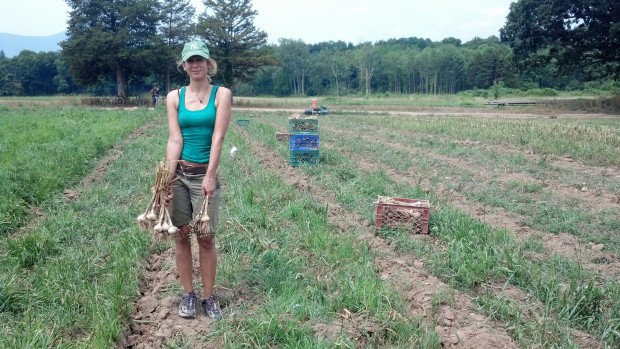

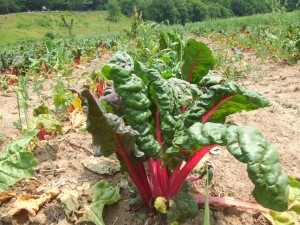

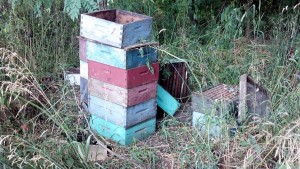
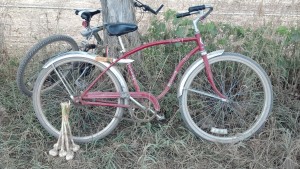
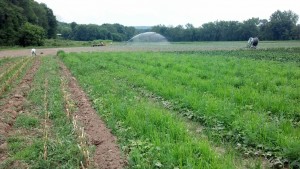
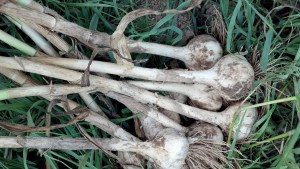
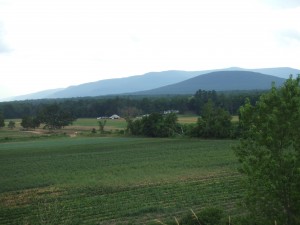



What a wonderful story! Thanks for reminding me of the many memories from my childhood gardening experience. If I learned anything from my grandfather, it was the appreciation for and importance of a home garden. Thanks for taking me back to my younger days in the garden with my grandparents and introducing me to yours!
Loved your story, Kristen! It’s 05:30. Could not sleep. Checked the computer, and WOW! Am really awake now. Purple garlic is the best. We buy it in long braids and hang it in the kitchen window. Forget the okra and try some giant, purple garlic on that grill! Continue your forays into the countryside — we want more stories!
This is great! I have been wanting to get to the farm for a visit, and reading this makes me want to go even more. My favorite part is the image of the chocolate lab running as if he were sliding into second base – you!! And the “Maggie’s farm” reference, of course. Looking forward to a part two after your next visit.
Loved this, K. Thanks for sharing. And I hope you send it out as an essay…or as part of a collection. And I’m jealous. Did I ever tell you of my CSA experience? That’s for another day…
Barb, can’t wait to hear about your CSA experience! Do tell!
Kristen,
Lovely piece. I forgot how much I could remember. I too had a grandfather who farmed … you brought it all back in such scrumptious detail. The porcelain garlic with the touch of purple, the stiffening in anticipation of a strange dog’s dive-bomb approach, you nailed the details. I especially enjoyed the way you solicited empathy (for migrant workers, Irene, a farmer’s gamble) without knocking your readers over the head. Really enjoyed reading it!
Thanks, Renee! “I forgot how much I could remember” too. I think the act of writing sometimes can make one’s memory click into focus in unexpected ways!
Kristen, thank you for writing such a thoughtful piece about your experience on “our” farm and thank you for sharing it with us. I loved that you and Scott have jumped right into the CSA activities this year and that you beat most of us to visiting the farm. I believe your words will entice more of us to go experience “where our food comes from!”
I really enjoyed reading this. You make me want to grab my gardening gloves and find a field. I can’t wait to read more!
Thanks for reading, Cassie! Herbs do well in Texas in the fall, whether in pots or in the ground, I’ve found (Fall=Texas’s second spring, yay!) PS. You might want to wear a pair “old” tennis shoes in the garden, like I did, LOL. (Continuing our insider shoe joke…)
Really enjoyed your article, Kristen! Your writing brought me right over to the dusty rows and delicious produce in between.
I joined Stoneledge CSA (Hastings) this year too and am now even more eager for the September farm visit.
Thanks, Tamera. We are in the Hastings CSA as well! (Great tomatoes today, btw 🙂 We hope to make it back up to the farm in September, too!
Thanks for the feedback, Amy! I almost cut the grandparent parts to stick to the “main” reportage; I’m glad I left them. I sometimes think that people have more vivid and memorable “food” associations with grandparents than parents, or at least, I do/did.
Great, great, great! And yum. And memories…best part was the stuff about your grandparents. So many great little details. Strawberries, two-toned Buick, striped figs…good stuff, Keckler! And great pics!